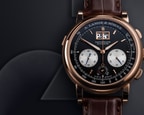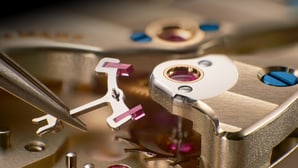Mechanical engineering for perpetuity
Perpetual calendars feature among the grand complications in watchmaking artistry. Elaborate mechanics consisting of hundreds of tiny parts assure the automatic correct display of date, day of week, month and leap year. Not only do the timepieces take into account the different durations of the months in a year, they also recognise which years are leap years.
Because of a peculiarity of the Gregorian calendar that omits the 29th of February in certain years, a manual correction is needed. Hence, the date must be advanced by one day each on 1 March of the centurial years 2100, 2200 and 2300.
Perpetual calendars with additional refinements
In keeping with our ambition to never stand still, our watchmakers continue to develop sophisticated technical solutions that complement or expand the calendar functions.
The typical Lange outsize date is one of the most prominent special features that we incorporate in the greater part of our perpetual calendars. The outsize date consists of two separate display elements: the units disc and the tens cross. Therefore, it is about three times larger than displays in watches with a comparable case diameter, making the reading of the arguably most important calendar function much easier.
Some of our models such as the LANGE 1 PERPETUAL CALENDAR and the DATOGRAPH PERPETUAL TOURBILLON are also equipped with instantaneously switching calendar indications, thus producing unambiguous readings at all times. The development of such a construction represented an impressive challenge since the switching process requires a significant amount of force that needs to be released within a fraction of a second at a given time.
With the launch of the LANGE 1 TOURBILLON PERPETUAL CALENDAR in 2012, A. Lange & Söhne broke new ground in finding unique mechanical solutions for the perpetual calendar. To preserve the one-of-a-kind dial layout of the LANGE 1 with its off-centre displays that do not overlap each other, the Lange watchmakers developed a peripheral month ring, which instantaneously advances at the end of each month.
How does the perpetual calendar work?
The core element of the calendar mechanism is the 48-step cam, which rotates only once every four years. It features recesses of various depths that are sampled by a finger. The deeper the recess, the sooner the mechanism switches to the first day of the next month. When the finger is not located in one of the recesses, but lies on the outermost circumference of the 48-step cam, the month advances after 31 days. The shallower recesses correspond to months with a duration of 30 days, and the deepest ones are reserved for the month of February when it has 28 days. The only recess that has a depth lying in between the two extremes marks the 29th of February occurring in leap years.
Often, our timepieces with a perpetual calendar are united with further horological complications, among which some of the most complex devices, such as a rattrapante chronograph, a tourbillon or a minute repeater. Each one of these mechanisms alone represents a grand complication ‒ the combination of two or more establishes a category of its own in the art of precision watchmaking.
Perpetual calendar
Complications



Explore further



How can we be of service?
Whether you are in search of a specific model, have questions out of interest or need a service request for your timepiece – we are delighted to help you. We are at your service by phone, email or in one of our boutiques.

















